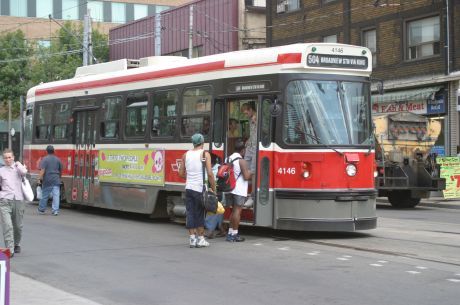Features
You are here
The politics of mass transit in the Greater Toronto Area

September 4, 2014
With Toronto mayoral election approaching, public transit has emerged as a key issue for candidates across the political spectrum, but why?
People are tried of sitting in traffic jams, Canadian cities have relatively limited transit systems, and air pollution and climate change are prominent issues. But all these things have been true for decades. The decisive reason why transit has been thrust to the fore at the current moment in the Greater Toronto Area (GTA) is that prominent sections of the business community have declared it a priority, and used their myriad means of influence to pressure for political action.
When and why does business support public transit expansion and when does it oppose it? Which sections of the business community are more inclined to be pro-transit? And most importantly, what are business’ priorities in shaping the transit agenda, who does and does not benefit from their agenda, and what is the progressive alternative?
Public transit and postwar capitalist growth
Capitalism requires many things to function smoothly. On the supply side, it needs good access to raw materials, a steady and reliable supply of credit, and a labour force that is sufficiently large, skilled, and compliant. On the demand side, consumers need to continuously purchase enough goods and services to keep the system’s wheels turning. To maintain investment levels—that is, the cycle of capital accumulation at the heart of the system—output must be constantly growing at a reasonable rate and be expected to keep doing so. The state serves as the mediator and overseer of the system—albeit not a netural one—and needs to raise substantial tax revenue while avoiding placing such a burden on business that it stifles profitability. Needless to say, while certain policies contribute to all the above priorities, there is often tension among them. Capitalism is full of contradictions.
Much of Canada’s current urban and suburban landscape first came into being in the several decades after World War II. During the demobilization immediately following the victory of the Allies, the overriding priority was to sustain demand as government military spending fell while converting industry from military to civilian uses. In North America in particular, the creation of suburbs was central to the spread of mass consumer markets. It was not only homebuilders who profited off the massive expansion of neighbourhoods featuring single-family homes, but also the auto, oil, and consumer goods industries, while banks offered mortgages. The state, of course, played a leading role in extending credit to families through loan guarantees, building roads, sewers, and highways, and annexing huge tracts of land to cities for development. From the point of view of business, suburban development was a boon, providing a wide range of opportunities for profit.
Of course, the suburbs were premised on residents owning private cars and driving to work and virtually everywhere else. While encouraging car buying, oil use, and retail shopping, mass car use contributed to increasing traffic gridlock. At a time when labour was in relatively short supply and tax revenue was plentiful due to a rapidly growing economy, business began to favour some expansion of mass transit alongside suburban development in order to ensure workers could get to work without undue delays. Toronto got its first subway in 1954, when what is now the southern portion of the Yonge line opened.
There was a tension here that remains to this day—business needed mass transit to maintain its labour supply and allow the smooth movement of highway freight traffic, but too much of it could cut into private consumption levels because mass transit is often in public hands and is in any event far more efficient (i.e. results in less consumer spending) than individuals driving their own cars. Hence transit was promoted in the densest areas, where gridlock was worst and adding more cars was difficult or impossible, but with car use being favoured for most people most of the time, above all in the suburbs.
As the GTA grew, transit did expand into the suburbs, though in a limited fashion. The Bloor-Danforth subway line entered service in 1966, while GO Transit (serving the outer suburbs) began operating in 1967. As the GTA’s population grew, so did gridlock problems, requiring public transit to be built to alleviate the worst traffic hassles. Nevertheless, business ensured its political allies did not go too far, maintaining a car-predominant commuting system. If the public transit network did grow substantially in the postwar period, highways sprung up even faster. The infamous Highway 401 was built in sections through the 1950s and 60s, as was the controversial Gardiner Expressway into downtown Toronto that today is crumbling due to neglect.
Neoliberal austerity arrives
Fast forward several decades to the 1990s. Piecemeal transit expansion had continued over the years, though never in ways that genuinely threatened the predominance of the car outside of Toronto’s downtown core. Mike Harris’ PCs were elected with strong, broad business backing in 1995, promising to crack down on welfare users and public sector workers while slashing taxes and public spending.
Part of the PCs’ public spending cuts involved halting capital financing for transit projects while downloading operating funding for local transit systems to the municipalities. The government went so far as to fill in the tunnel being bored for the Eglinton subway (ironically, now under construction once again, though this time in LRT form). By all accounts these cuts hurt the quality of transit services in the GTA and meant years of stagnation in terms of new construction.
Why did most of the business community rally behind Mike Harris’ agenda, including transit cuts, even though they risked worsening costly gridlock? In short, because business saw lowering taxes and cutting deficits as the overriding priorities at the time. Unlike in the 1960s, public finances at all levels were not particularly healthy and business felt it had the political might to enhance profits by pushing for a lower tax bill while also calling for lower deficits.
Facing austerity’s contradictions
With the resolution of the perceived fiscal crisis at the provincial and federal levels following massive tax cuts alongside surpluses or at least reduced deficits in the late 1990s, business began to take stock of the results of the vast cuts to public spending that had occurred. On the transit file, the problem of gridlock was worsening, and businesses realized this was resulting in significant costs for them. An additional factor that grew in importance, particularly from the mid-2000s, was the booming real estate market in downtown Toronto, with condo developers becoming a major political force in favour of transit expansion because it raises land values.
The 2000s saw many transit plans promulgated and scrapped as the political winds changed. By the 2010s, however, business began to push back against further delays. In its brief on the 2014 municipal and provincial elections, the Toronto Region Board of Trade listed regional transit expansion as the first of four key priorities for the area. Another prominent business lobby group, Greater Toronto CivicAction Alliance (headed from 2010 until earlier this year by businessman John Tory, now a candidate for Toronto mayor) has launched a region-wide ad campaign to build public support for transit expansion.
Transit for whom?
There is no doubt that the status quo of stagnation carried over from the Harris years is a social and environmental disaster that will only keep growing. We must be careful, however, to identify why business supports transit and what its goals are in shaping transit policy. What are the key components of business’ transit agenda, and how have they worked their way into GTA transit policy?
1) A disproportionate focus on weekday commuting from the outer suburbs to downtown. This is the main task of the GO system that is now the target of major expansion under provincial transit agency Metrolinx’s The Big Move. Business is enthusiastic about this kind of transit because it is the main vehicle to get skilled white-collar workers from their suburban homes to jobs in finance and other capital-intensive sectors located disproportionately in the downtown core. This kind of transit is certainly necessary and desirable; the problem is that other types of transit less important to this particular function are neglected. Poor local transit in 905 municipalities means the GO system is still largely reliant on workers driving and parking at GO stations, meaning they must own private cars in addition to paying GO fares. Suburb-to-suburb commuting by transit is also limited.
2) High transit fares, which amount to a highly targeted and regressive form of taxation—much more so than even sales taxes, let alone corporate and personal income taxes. High fares mean workers bear the brunt of the cost of operating the transit system. In Toronto, TTC fares are exorbitant, with a monthly adult pass costing $133.75. For low to moderate income families this is a major expense. Fares are so high because public subsidies are so low, with the TTC receiving only 78 cents per rider, the lowest among comparable transit systems in North America. The GO system is even pricier, and recovers virtually all its operating costs at the fare box. Taking into consideration that users must usually either own a private car to get to the station or pay for a separate municipal transit pass, the GO system is not an affordable option for many workers. The pro-transit business lobby seems remarkably unconcerned by this state of affairs, however. On the capital funding side, meanwhile, the difficulty it faces is how to pay for capital expansion without raising corporate or personal income taxes it wants to continue to be cut. The solutions the business lobby is proposing mostly involve raising regressive taxes by placing tolls on roads or raising sales taxes, though it is facing substantial public resistance to such means of financing.
3) The drive to privatize is heating up like never before. Traditionally, transit projects have been designed and financed, operated, and maintained by public agencies, with only construction contracted to the private sector. With the push for so-called “public private partnerships” (P3s), an increasing number or even all of these functions are being contracted to private consortia. Though the business lobby alleges these arrangements cut costs, systematic in-depth research has questioned this assertion. In fact, P3s typically involve higher financing costs, as governments can inevitably borrow money more cheaply than private companies, and P3s must include a margin for private profit public agencies do not require. When costs are saved, it is often by driving down working conditions, reducing the number and/or quality of transit jobs. Metrolinx is building the Eglinton-Crosstown LRT under a P3 arrangement, as is Waterloo Region for its LRT project. It is no secret why business likes P3s, of course—they provide opportunities to make huge sums of money to deliver public services.
4) Transit governance structures are increasingly unaccountable. Metrolinx, the recently created provincial agency overseeing transit development in the GTA, has its Board of Governors appointed by the provincial cabinet, with members coming overwhelmingly from the private sector. This gives business a way to directly shape the transit agenda according to its wishes and offers few means for the public to hold the leadership of the agency to account. Many, including some on the centre-left, see the creation of Metrolinx as an opportunity for enlightened bureaucrats to make progress on transit by bypassing the rough and tumble of elected politics, particularly at the municipal level. This is profoundly undemocratic, however, and it is a mistake to see this as genuinely progressive. If members of the public feel left out of transit governance, in the current climate this will only fuel the kind of right-wing populism that elected Rob Ford four years ago.
A democratic alternative for transit in the GTA
Critiquing the business agenda for transit does not mean, of course, opposing transit expansion. The question is how to expand and reform transit in ways that improve service to all residents of the GTA while cutting inequality, air pollution, and carbon emissions and providing good jobs for transit workers. What would a genuinely progressive agenda for transit look like?
1) We need to demand a much more ambitious and holistic plan for expansion. We should expand GO, we should build a downtown relief line, we should built LRT in the suburbs—at a bare minimum those lines proposed in the Transit City plan—as well as immediate and permanent expansions to bus service in the City of Toronto and surrounding areas alike. Olivia Chow’s promise to improve TTC bus service is a start but is far too timid, costing only $15 million out of the agency’s $1.5 billion annual operating budget. In short, we need a transit network that allows continued growth of core ridership but that is also fast and reliable enough to allow those in the suburbs (416 and 905 alike) to give up their cars. This will not happen overnight but is feasible in the medium term. Yes, building and operating transit is costly—tens of billions of dollars for a serious, comprehensive plan—but the alternative to transit is continuing the orgy of public and private spending on maintaining a society built for the private automobile, which is pushing us towards climate chaos.
2) The main source of operating funding for transit should be general tax revenue while capital funding should be sourced from a mix of general taxation and long-term government borrowing. Lowering fares and increasing public operating subsidies has two key benefits: it is much fairer to those on low and moderate incomes, and it encourages transit ridership. Business’ aversion to government borrowing to pay for transit construction in the current climate is particularly ridiculous given the rock-bottom interest rates on offer in the wake of the global economic crisis. Borrowing to build transit allows governments to take advantage of cheap money while also stimulating the economy.
3) Transit should be designed, funded, operated, and maintained publically. Public ownership allows for control of costs, the protection of good quality working conditions, and above all for public accountability. Boards appointed from the private sector should be abolished. Clearly coordination across jurisdictions is needed, but any central agency should have its leadership directly elected by the public, with extensive mechanisms for direct debate and engagement rather than merely non-binding consultations. And decisions should be devolved wherever possible to the local level, where community councils could identify neighbourhood priorities—albeit within the limits of a coordinated regional framework.
How to change the channel from a business agenda on transit to a democratic one is of course the toughest question. The door to public discussion has already been opened with transit appearing all over the news. ATU 113, representing TTC workers, has launched an impressive campaign designed to critique the privatization agenda, which is an excellent start. If the links can be solidified between these efforts and the movement for green jobs, the activism of transit riders, and the broader left mobilization around the upcoming municipal elections, the possibilities for a transit system serving people above profit will be substantially enhanced.
Section:










